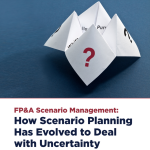Scenario management plays a vital role in a world of irrelevant budgets and inaccurate forecasts.

The pandemic has highlighted the importance of scenario and contingency planning. In a world of increasing uncertainty, organisations need to be agile. Scenario Planning provides a structured approach to proactive planning rather than taking reactive actions. However, to succeed in Scenario Planning, an organisation should assess its ability to deliver results in three key areas: data quality, technology and people.
Data: Providing Relevant Insights
Good quality data is an important element in Scenario Planning. Data should be fit for purpose and accessible in a timely fashion. There is a misconception that the more data collected, the better. This is not always the case. Data should be relevant. An organisation needs to understand its operational and financial processes and identify its KPIs to determine its relevance. Once KPIs are defined, the business can identify the relevant drivers to each KPI and the data that is needed to measure them. This process feeds into Scenario Planning because the drivers form the variables that will affect the results. The role of the FP&A team is to work with different parts of the organisation in translating qualitative drivers into quantitative drivers for Scenario Planning.
Technology: Moving from Being Gatekeepers to Being Enablers
There are many different technologies and tools in the market for Scenario Planning. The tool should enable the users to simulate different situations with agility and a certain level of accuracy. When choosing the appropriate technology, you need to keep the following in mind:
- Input controls help ensure that any data required to be entered by the user is in the appropriate format. This is usually the modification of the variables. There should also be validity checks on inputs for reasonableness and an audit trail of changes.
- Assumptions drive changes in the variables and the model computation that shows the results of each scenario. These are one of the most significant human inputs. They show how changes in each variable can impact the financial results if the organisation does nothing.
- Version control allows users to review several iterations and provides a form of accountability.
- Agility. The purpose of Scenario Planning is to simulate company results under different circumstances. The model should be agile enough that it can grow with the organisation as it evolves.
- Ownership. There should be clear ownership of the master data and the tool. Although the business may own the budgets and the forecast, FP&A is the owner of the master data and the tool. This is necessary to protect the integrity of the model and the results that it generates.
All of the above suggests the need for a dedicated tool rather than simply performing Scenario Planning using spreadsheets. Spreadsheets are not designed for complex and agile modelling. They also require more maintenance time to ensure that they are “foolproof” since they are prone to corruption. On the other hand, a dedicated Scenario Planning tool provides the flexibility and security required for agile planning. This, in turn, allows FP&A to be the enablers of business decisions rather than the gatekeepers of the data.
People: Becoming a Trusted Business Advisor
Businesses are made up of people – the owners, the management, the workforce and their customers. Therefore, the FP&A team needs to consider the human factor in Scenario Planning. FP&A professionals also need to build rapport and trust with their stakeholders to promote organisational collaboration. Transparency during the Scenario Planning process can alleviate possible conflicts between FP&A, management and operation teams as relationships are established. Transparency involves the communication of objectives and goals, actions and the impact of actions (as well as non-actions). Communication is not limited to down-chain communication from management but also feedback from operations to FP&A teams and management.
Finance business partners (FBPs) play a key role in Scenario Planning by translating qualitative elements into quantitative elements. FBPs also work with operations to turn the results from Scenario Planning into executable actions.
FP&A teams should validate the results generated from the tool since these results will form the basis of their recommendations on what actions may be required in the scenario that is being analysed. Credible analysis and insight through Scenario Planning enable the FP&A team to become trusted partners to the business. The FP&A team will no longer take a back seat but join the organisation’s growth journey.
Conclusion
Scenario Planning gives the organisation a view of the interrelations between its operations and its actions. It shows the impact on a company’s financial performance when changes are made to any one factor. However, Scenario Planning is not a crystal ball.
As Donal Rumsfeld, a former US Secretary of Defence, once said, “There are known knowns – there are things we know that we know. There are known unknowns; that is to say, there are things that we now know we don’t know. But there are also unknown unknowns – things we do not know we don’t know.” Scenario Planning can help manage some known variables so the business can be more prepared and proactive. This means that what may be a crisis to others can become a managed situation for the organisation.
Disclaimer:
Any views or opinions expressed are solely those of the author and do not necessarily represent those of any companies for which the author has been and is working.
This article was first published on Unit4/Prevero Blog.
Subscribe to
FP&A Trends Digest

We will regularly update you on the latest trends and developments in FP&A. Take the opportunity to have articles written by finance thought leaders delivered directly to your inbox; watch compelling webinars; connect with like-minded professionals; and become a part of our global community.





